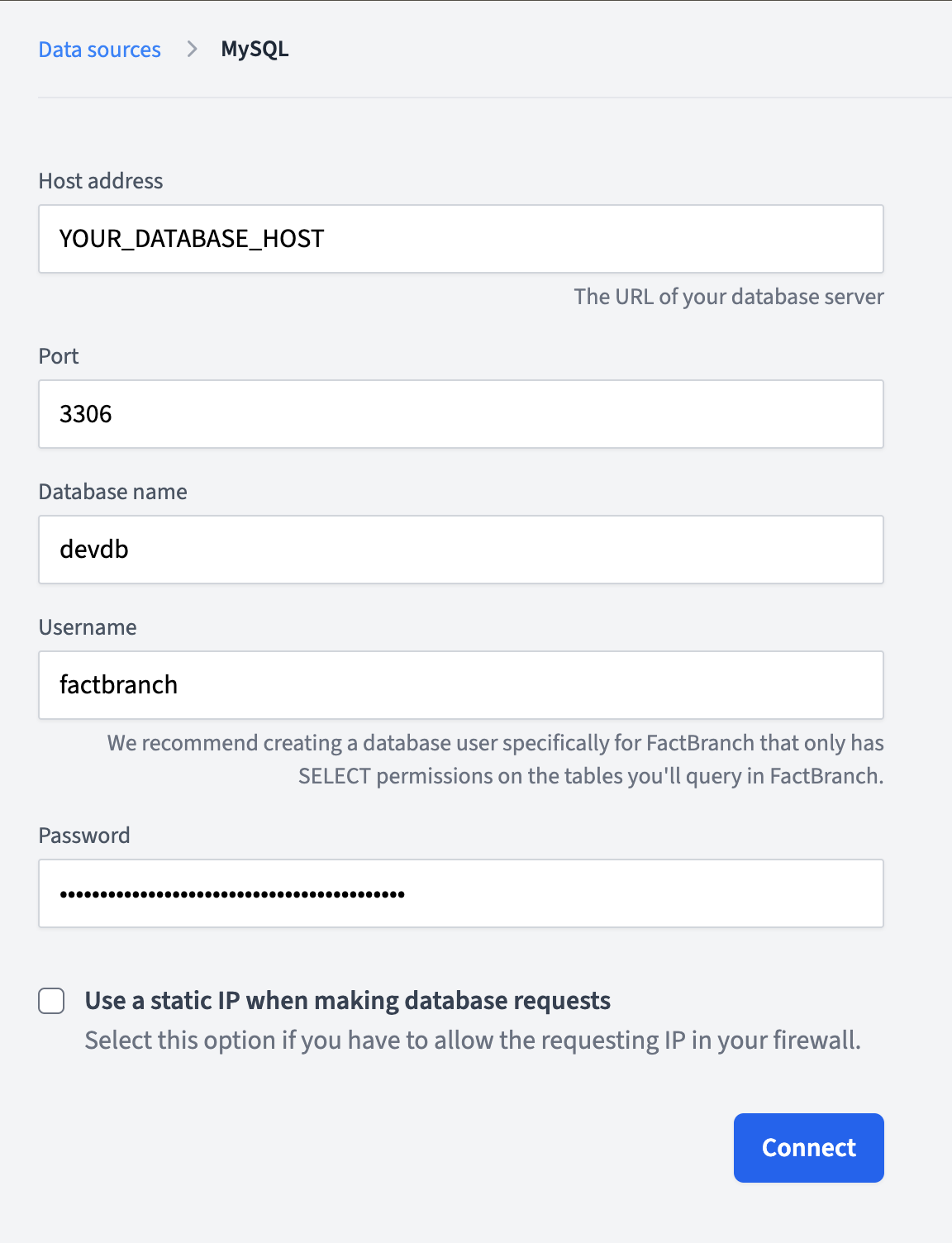The first step in querying your MySQL database is to connect FactBranch to your MySQL instance. You do this by creating a MySQL Data Source in FactBranch.
Once you've entered your credentials in the authentication, they are stored on FactBranch's servers, encrypted-at-rest and the password will never be shown again anywhere in your FactBranch account.
You can, however, use the authentication in your nodes. This allows you to save the credentials once and then re-use it in several nodes. You can even let another team member create nodes and use the data source without them seeing the credentials.
In this article you'll learn:
We recommend creating a dedicated user for FactBranch with only the permissions it needs to run your queries. Typically this means giving read-only access on the tables you will query.
This is a basic example of how to create an appropriate user in your MySQL database. Use this as a starting point depending on your own requirements.
Create a database user for FactBranch. Replace all values surrounded by <...>
with your own values.
CREATE USER 'factbranch'@'%' IDENTIFIED BY '<PASSWORD>';
Grant the user read-only access to the databases and tables you want to query:
-- Grant read access to a specific database
GRANT SELECT ON <your_database>.* TO 'factbranch'@'%';
-- Or grant read access to specific tables
GRANT SELECT ON <your_database>.<your_table> TO 'factbranch'@'%';
-- Apply the changes
FLUSH PRIVILEGES;
If you're using Amazon RDS, you can create the user through the AWS console or using the same SQL commands above. Make sure your RDS security group allows connections from FactBranch's static IP address.
To create a MySQL authentication in FactBranch, click on Add data source in your Data Sources dashboard, then select MySQL. You'll be forwarded to the credentials form.

your-instance.region.rds.amazonaws.comfactbranch.
Once you've filled out everything, click Connect. FactBranch will test the credentials you've entered by attempting to connect to your database. If it was successful, you'll be forwarded to the list of data sources and you'll see your newly created MySQL authentication in the list.
You can now use this authentication in a MySQL node to run SQL queries in your MySQL database.
To rename the data source, either click on Rename next to the title, or double-click on the title itself. Then enter the new name and click on Save or hit Enter on your keyboard. To revert to the old name, hit the Escape key.
First create a MySQL node in one of your Flows. Edit the node by clicking Edit next to the node in the Flow Editor. Select the Authentication tab on the left side of the screen. Then click on Select an authentication... - or on change... if that node already has an authentication associated. Select the authentication you'd like to use and from now on this node will use for all its requests the credentials you've stored in the authentication.
If you get a "connection refused" error, check that: - Your MySQL server is running and accessible - The host address and port are correct - Your firewall allows connections from FactBranch's static IP address
If you get an "access denied" error, verify that:
- The username and password are correct
- The user has been granted SELECT permissions on the database/tables
- The user is allowed to connect from external hosts (using 'factbranch'@'%')
FactBranch connects using SSL by default. If your MySQL server doesn't support SSL or has SSL configured differently, this might cause connection issues. Most modern MySQL installations support SSL connections out of the box.